Going for Broke on Baffin Bay
Trophy redheads and pintails await those who can navigate this estuary's treacherous underwater reef formations
Trophy redheads and pintails await those who can navigate this estuary's treacherous underwater reef formations

By Chris Jennings
I was clutching the crossbar that runs along the center console of Captain Sally Black's 23-foot custom Haynie Cat as we skipped across Baffin Bay's wind-churned waters. Spray arced from the gunwales with each slapping wave, but our guide didn't seem too concerned about the weather on this hazy gray December morning. Keeping one hand on the wheel, she used the other to tap out text messages to the two boats off our stern. All the while, her eyes tacked carefully back and forth between the console-mounted GPS unit and the water ahead.
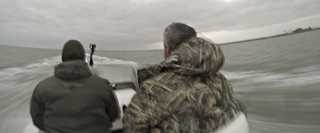
Photo Chris Jennings
Captain Sally eased off the throttle and aimed the bow toward the shoreline. The other two boats continued on a little farther, and that's when the ducks got up. Big flocks of pintails, redheads, and wigeon scattered as the trio of boats interrupted their morning feeding. "Oh, I love this spot," Sally said excitedly as she bumped the throttle forward and trimmed the 225-horsepower Mercury motor to ease us toward a lone mesquite tree poking out of the eroded shoreline. Clouds of ducks suddenly rose from freshwater impoundments further inland.
"I think I love this spot too," I said to myself, even though this was the first time I had ever laid eyes on it.
After getting our marching orders from Sally, Ted Gartner and I gathered up decoys, guns, bags, and chairs, and then hopped out of the boat into eight inches of water and a hard-sand bottom. Gartner is director of media relations for Garmin, the sponsor of our three-day Texas waterfowl hunt. The excursion provided a fine opportunity to test the company's new handheld and boat-mounted GPS units.
Navigating Baffin Bay's notorious rocks, sandbars, and channels can be challenging. Fortunately, Captain Sally and her husband, Aubrey, are seasoned veterans of these treacherous waters. The couple run Baffin Bay Rod and Gun, a full-service lodge and outfitter business in nearby Riviera. They specialize in connecting anglers with the trophy sea trout that grow in the high salinity of the bay and in providing waterfowlers with opportunities to take prized redheads, pintails, and other ducks that winter along the Upper Laguna Madre.
Sally motored the boat several hundred yards away and out of sight. In the meantime, Gartner and I tossed out three dozen decoys. We set up a few lawn chairs on the beach, right under the mesquite tree. Then we quickly built a makeshift blind out of palm fronds tied to rebar stakes, which we pushed easily into the soft sand in front of the chairs.
Before our guide could even reach the blind, flocks of redheads began to appear on the horizon. "They're coming right in!" Gartner said as a couple of birds decoyed almost at full throttle. Two shots rang out in close succession, and two redheads fell on the water.
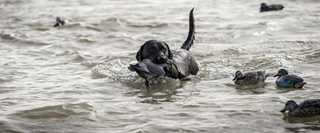
Photo Beau Rapelye, Garmin
The Texas Gulf Coast is legendary for its redhead hunting. Most of the continent's supply of these diving ducks winter along the Laguna Madre, feeding on the great beds of shoalgrass that flourish in the hypersaline waters of this clear, shallow estuary. Abundance, however, isn't the whole story. The best thing about hunting redheads is their willingness to decoy, often in huge flocks.
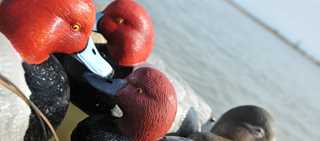
Photo Chris Jennings
When Captain Sally and her Lab, Kelly, joined us in our palm-frond hide, I asked her why there seemed to be so few waterfowlers on Baffin Bay compared to other areas of the Laguna Madre. "There may be a few other hunters here and there, but the rocks keep most of them away," Sally explained. "Also, with the Kenedy Ranch to the south and the King Ranch on the north, this really is a remote area. Those private ranches keep development to a minimum. And because there are no manmade navigational markers, it's really hard to navigate down here. I was lost for the first six months that I was down here."
Funding derived from the Gulf Coast Initiative enables Ducks Unlimited to conduct important science, public policy, and outreach efforts, as well as conserving habitats important to waterfowl that migrate and winter on the coast.
Sally is a transplant from the Upper Midwest. This is apparent when she speaks as her northern accent overpowers subtle hints of a Texas twang. She was born and raised in Michigan, where she fished with her father on the abundant freshwater lakes and rivers. She moved to Texas because she wanted to own horses, and she did, but now she owns a pack of Labrador retrievers, as well as a mutt named Cochita, a stray that had wandered close enough to Sally to become a part of the family. That family aura surrounds Sally, which is probably why people, her clients, and stray dogs are drawn to her presence. "I guided kayak fishing and fly fishermen for a while, and then I met Aubrey and ended up down here," she explained. "We both love to fish and huntand we love our dogs."
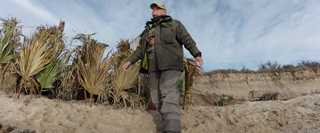
Photo Chris Jennings
As flocks of redheads continued to appear on the horizon, Sally stared out at the bay and added, "There's just something special about this place. It's remote, almost untouched. There are no high-rise buildings along the shorelines, and little traffic on the water. That's what makes this a happy place for the ducks, I guess."
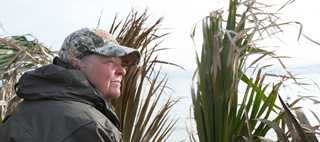
Photo Beau Rapelye, Garmin
Gartner and I were happy, too, when another flock of redheads rocketed into the decoys and we quickly filled our two-bird limits on these beautiful divers. Fortunately, there are plenty of pintails and other dabblers to round out a hunt. As luck would have it, however, the sprigs and assorted dabblers proved to be much more challenging to lure into shooting range on that first morning.
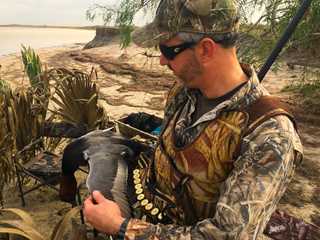
Photo Chris Jennings
Back at the lodge, we mingled on the big patio as Texas-sized steaks sizzled on the grill. As we wiped down our guns and discussed the morning's adventure, the conversation turned once again to the lack of hunting pressure. "There are two types of boaters running around in Baffin Bay," explained Captain Aubrey, a 54-year-old, third-generation West Texan who has been plying the bay's waters for almost two decades. "Those who have lost a lower unit, and those who will."
Aubrey explained that the bay is brimming with "rocks," which are actually reefs created by colonies of tube-building worms called serpulids. As the worm colonies grew over thousands of years, these calcium carbonate structures, or reefs, grew as well. Over time, however, the bay became too salty for the proliferation of tube worms and the reefs stopped growing. Now these fragile structures are increasingly threatened by boaters and anglers, as well as by other activities. This is a concern for fishermen and other conservationists, because the reefs provide shelter and protection that fish and other marine organisms seem to thrive in.
"If you don't have the rocks charted, and very few people do, it really isn't even safe to run out here," Aubrey continued. "We always wait until first light to launch if the weather conditions aren't perfect. There are only a handful of people who spend enough time down here to know the water, and Sally and I are part of that group. I've been guiding down here for 17 years, and I find new rocks all the time. Some are the size of small cars."
During this trip, Captains Aubrey and Sally used Garmins GPSMAP 78 to plot courses, chart rocks, and set new waypoints.
"This particular unit is ideal for the shallow-water duck hunters, says Ted Gartner, Garmin media relations director. While it can be mounted on the boat, being able to use it as a handheld when away from the boat is ideal."
GPSMAP 78 features crisp color mapping, high-sensitivity receiver, new molded rubber side grips, plus a microSD card slot for loading additional maps. With its high-sensitivity, WAAS-enabled GPS receiver and HotFix satellite prediction, GPSMAP 78 locates your position quickly and precisely and maintains its GPS location even in heavy cover and deep canyons.
The next morning we were greeted at the boat ramp by two peacocks roosting on wooden utility poles. The birds, draped in gaudy plumage, squawked and screamed at us as we launched the boat. This scenario played into the eccentricities of Baffin Bay.
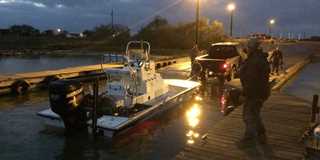
Photo Chris Jennings
Soon we were shooting across the bay in our guide's Bigfoot Haynie. Scott Ashton, regional sales manager for Garmin, and I were tucked against its center console when Captain Aubrey suddenly turned hard to follow the contour of the shoreline. "There, see that sandbar?" he said. "That's where were going."
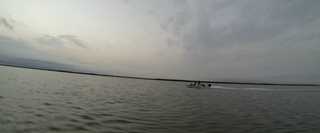
Photo Chris Jennings
The sandbar in question was covered with hundreds of pintails, redheads, and various other dabblers and divers. The birds flushed off the bar and scattered in all directions as we motored into the cut. Aubrey pulled the boat up on the sandbar and we climbed out carrying armfuls of palm fronds, decoys, guns, chairs, and other gear. "We'll cross here," he said. "It may be a little muddy, but there's a path." The ducks were already starting to return, so we were anxious to get set up on the shore.
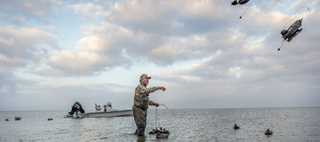
Photo Beau Rapelye, Garmin
We waded across the shallow water and then tossed out the decoys between the shore and sandbar. The shoreline was erodedit dropped off sharply about six feet to the water's edge. We set our chairs on a small mound of rocks and sand at the base of the sand bank and concealed them with the palm fronds.
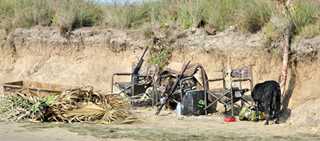
Photo Chris Jennings
The first birds to fully commit to the decoys were mottled ducks. The pair scanned the sandbar, spotted our decoys, and flew right in. Wings cupped and feet down, the birds were just above the water by the time Ashton and I swung our shotguns and dropped them into the decoys.
Suddenly, the air was filled with the whistling calls of pintails. We heard the birds before we saw them. Aubrey was the first to spot them. "There, on our left!" he said as a dozen or more pintails appeared on our port side and then swung around into the wind. The birds' distinctive long necks and trailing sprigs were clearly visible as they glided gracefully toward the decoys. "Take 'em!" our guide said. And we did.

Photo Chris Jennings
Three beautiful bull sprigs fell to our guns. Aubrey's black Lab fetched each bird in quick succession. After taking the last pintail from his dog, our smiling guide smoothed out the bird's feathers. "This is what people call and ask about, the drake pintails with the big chocolate heads," he said. "Pintails are great anywhere you can get them, but these drakes down here, in their full wintering plumagethey're extra special."
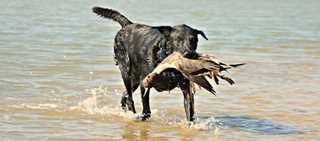
Photo Chris Jennings
Diving ducks, for some reason, have attained a bad reputation in regards to table fare. While they may not garner the same table fare respect as the mallard, or wood duck a limit of diving ducks stacks the same in the kitchen.
This recipe from Scott Leysath, DU magazine cooking columnist, may turn a diving duck naysayer into a culinary believer.
Following two sorties of redheads that that had approached the decoys somewhat erratically, we had empty shell casings but no birds to show for it. The next flock of pintails paid the price for our poor shooting on the redheads, however, and each of us bagged another drake. My duck strap held two beautiful northern pintails and a mottled duck, a strap I'd be delighted to have on any given day.
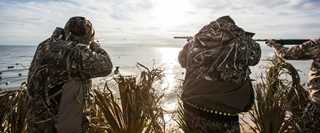
Photo Beau Rapelye, Garmin
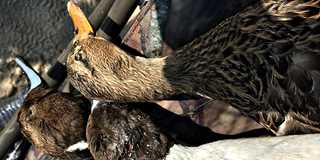
Photo Chris Jennings
After that, the morning flights petered out as the birds headed inland for the freshwater impoundments. The lull gave us an opportunity to sit and soak up the sun and the serene beach atmosphere.
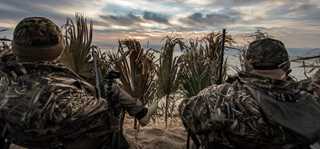
Photo Beau Rapelye, Garmin
"Honestly, this is great," Ashton said, as he leaned back in his lawn chair, legs stretched out toward the water. "It's 70 degrees, my feet are in the sand, and we are staring out across the bay. It's probably snowing back in Kansas City. I could get used to this."
Warm weather and a unique hyper-saline ecosystem can create issues for typical waterfowl hunting gear. The following items are a list of gear reccomendations which will come in handy as you plan your trip for the Texas Coast.
We loaded up the gear and piled into the boat. On the way back to the lodge, we never saw another group of hunters on the water. As a matter of fact, I believe we only saw two fishing boats during the entire trip.
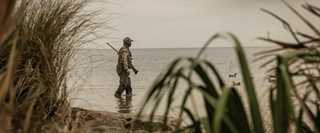
Photo Beau Rapelye, Garmin
Later that afternoon I asked Aubrey if he ever worried that too much publicity might cause hordes of freelance hunters to suddenly descend on his secluded piece of duck hunting heaven. "I really don't," he said. "Baffin Bay isn't very forgiving to freelancers who don't know the area well. Your best bet is to hire a knowledgeable guide."
Of course, if you don't take his advice, and Captain Aubrey finds you stranded near one of his favorite hunting spots, the lower unit of your outboard sheared off by one of the bay's submerged rocks, he'll gladly give you a tow back to the boat dock. The waters of Baffin Bay may be unforgiving, but its guides are as welcoming and kind as Texas is wide.
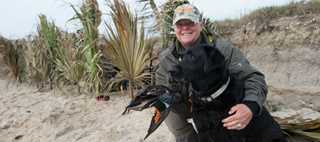
Photo Beau Rapelye, Garmin
Ducks Unlimited uses cookies to enhance your browsing experience, optimize site functionality, analyze traffic, and deliver personalized advertising through third parties. By continuing to use this site, you agree to our use of cookies. View Privacy Policy